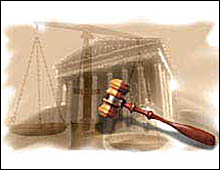Clarendon Law Lecture

I just returned from the Clarendon Law lecture here at Oxford given by Justice Stephen Breyer of the United States Supreme Court. This is the second time I have had the pleasure to hear a public talk given by an existing member of the US Supreme Court (the first being Justice Antonin Scalia). And, like the first experience, it was an amazing presentation and real joy to listen to.
Justice Breyer’s talk (the first of two) addresses issues from his new book Active Liberty: Interpreting Our Democratic Constitution.
Below I will do my best to outline the general thrust of his presentation, though this brief outline is from my memory and notes taken by me during the 60 minute talk:
Justice Breyer began by noting that, just 15 minutes before his talk began, that his 3rd grandchild had been born. After some opening comical remarks- which immediately warmed the audience to him- he noted that his talk would address two things. Firstly, he would begin with some reflections on the US Constitution. Secondly, he would talk about his new book, which is a book about democracy (more specifically participatory democracy).
First Section: What is the Constitution? What does it do? Justice Breyer succinctly summarized the various components of the Constitution. Basically, the Constitution creates the Federal government.
Justice Breyer emphasised the importance of James Madison’s insight that “This is a Charter granted by Liberty…”. Unlike Europe, where power existed with the King, the U.S. was to start afresh. And the people were to decide how to live together.
Justice Breyer also noted that most law in the United States comes from the (50) states. Of course the Constitution does trump state law. And each year the Supreme Court receives around 8000 requests to hear cases, and decides to hear roughly 80 or so cases. What are the criteria for deciding to hear a case? The main criterion is that the judges believe there is an issue that needs a uniform rule. (For example, because there is disagreement in lower courts).
Second Section: Justice Breyer then turned to the argument in his book. Why write the book? What is it about the Supreme Court that is so different from, for example, appellate court? The Supreme Court is special because you begin to see the Constitution as a steady guide… you see different parts of it (more frequently). Is it possible to see the document as a whole? Justice Breyer claimed that once you have been on the Supreme Court for a while, you do.
So the central answer as to what the Constitution does, for Justice Breyer, is it creates democratic instruments of government. It inspires a certain kind of democracy, one that protects rights, equality, separation of power (both horizontally and vertically) and it insists upon the rule of law.
One might then wonder: "What are judges doing?" Justice Breyer claimed that they are basically on border control. And life on the border can get difficult.
Then Justice Breyer turned to the notion of “Active Liberty”. This is the idea that the people are to participate in the system… to decide what kinds of rules they want to live by. And this reading of the Constitution (that its purpose is to facilitate the exercise of Active Liberty) can actually help Supreme Court judges decide a case… to arrive at a reasonable answer.
Justice Breyer then provided some examples. For instance, campaign finance reform. Does it violate the 1st Amendment? Not easy to answer (though some think it is easy to answer). Important question to ask: What is the 1st Amendment there for? Answer: for democratic government, to allow the people to participate. So facilitating dialogue is important. What happens when a handful of people (with huge contributions) take up all conversational areas? So recognising the importance of conversational areas is related to the democratic principle. And thus the real important questions, when it comes to campaign finance reform, are- when? How much? Under what circumstances? Etc. Such restrictions can further (not stop) the democratic conversation.
Justice Breyer also gave further examples dealing with Affirmative action, technology, security, etc. He stressed that it is important that judges come in (if they must) at the end (not the beginning). They should let the process work itself out.
This account of Active Liberty provides, argued Justice Breyer, a general view of law. One that pays a lot of attention to purposes and consequences. Most judges, when faced with a difficult legal case, utilise 6 basic tools: (1) look at the text (2) tradition: what have the words come to be in law? (3) precedent (4) history (5) purpose (or value underlying the text) and (6) consequences: what will happen if I decide this way versus that way. Justice Breyer stressed these last two (some judges emphasis the first 4 more).
Thus concludes Part 1 of Justice Breyer’s Clarendon Lecture. I am hoping to make it to the second part tomorrow evening if I can. It was a joy to listen to his judicial philosophy, and much of what he said resonated with my own thoughts about the role of the judiciary and democracy (as expressed here and here). I look forward to reading Breyer’s new book.
Cheers,
Colin


<< Home